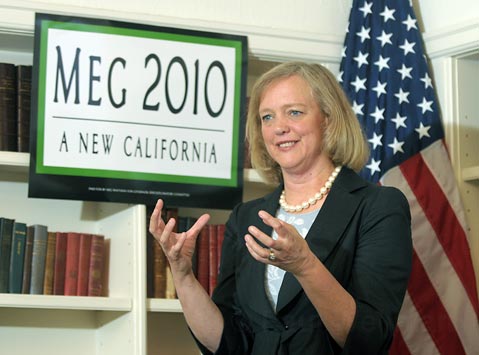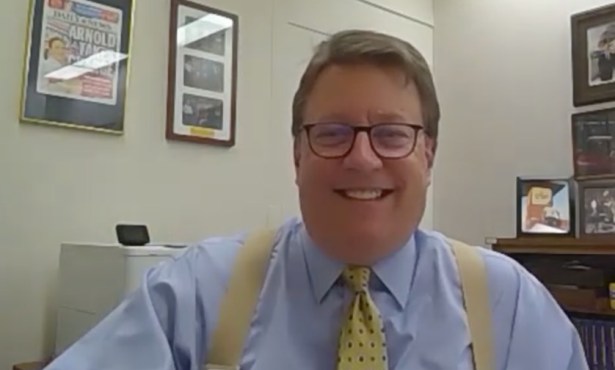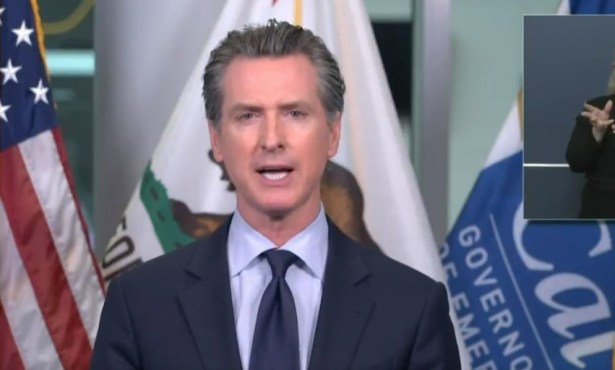Meg-a-Millions
GOP Billionaire Leaps Ahead in Horse Race for Governor

Two months before the California primary, the race for governor boils down to three words: Meg Whitman’s money.
As the former eBay CEO hints she may spend an unprecedented $150 million on her campaign by November — most of it her own money — a new Los Angeles Times poll shows the impact of the record-shattering $39 million she already has personally forked out for wall-to-wall TV advertising: Whitman not only is overwhelming Republican rival Steve Poizner but also has moved ahead of Democrat Jerry Brown, whom she now challenges for several key constituencies.

Since January alone, Whitman has purchased more than $25 million of television advertising — $358,000 a day or about $15,000 an hour — buying everything from Lost and The Biggest Loser to NASCAR racing and every NCAA basketball tournament game broadcast; this week, she announced she was putting another $20 million into the pot.
While some of her ads have been negative attacks on Poizner, most have been gauzy bio spots that advance her core argument — that her business experience has ideally positioned her to be governor.
The new L.A. Times study, conducted in partnership with USC, was the first independent poll that specifically measured the effect of her advertising barrage. Among other findings, it showed that:
• Of all voters surveyed, two-thirds said they have seen a political ad in 2010 — and 75 percent of those said it had been aired by Whitman.
• Of those who have seen her spots, three in four said they favor her over Insurance Commissioner Poizner, while only 38 percent of those who haven’t seen her ads support her against him.
• Of voters who have seen Whitman ads, 53-40 percent favor her over Attorney General Brown; among those who have not seen her ads, 40-33 percent favor Brown.
“The survey demonstrated how thoroughly Whitman … has dominated the California elections thus far,” Times political writer Cathleen Decker reported.
As a political matter, Whitman’s campaign strategy is based on the military principle of overwhelming force. A billionaire, she has simply buried the more modest ad buys of Poizner, himself a multimillionaire, and received a free pass from Brown, who is unopposed in the Democratic primary and has spent almost nothing on his campaign so far.
Whitman’s ability to spend freely at such extraordinary levels presents Brown with a difficult strategic dilemma. With a campaign budget of $25-$30 million, he has about $15 million in the bank, which under ordinary circumstances would put him in a strong position.
These are not ordinary circumstances.
As a practical matter, Brown’s fundraising will allow him to afford perhaps 12-15 weeks of sustained TV advertising, so he needs to carefully pick his shot about when to spend it. If he goes after Whitman now, he runs the considerable risk of having little or nothing left for the fall, when most voters will tune into the campaign; if he waits until then and Whitman becomes the
Republican nominee, however, he will be forced to endure months of expected pounding without answering her expected on-air attacks.
That raises the scenario that the broad support Whitman has begun to build in recent months, which is not yet firm, will solidify, leaving Brown in a too-little-too-late posture.
The new poll shows some critical danger signs for the Democrat: While support for him and Whitman is divided evenly among male voters, the Republican now runs ahead among women — who historically back the Democrat by significant margins. And independent, decline-to-state voters, whose swing to Democrats has been crucial in many recent statewide races, are also splitting their support between the two, to the benefit of Whitman.
WHEN IT RAINS, IT POURS: Poizner, who once was considered the front-runner for the Republican nomination, can’t buy a break. Losing by 40 points to Whitman, the insurance commissioner last week unveiled his education plan, timed to coincide with the release of Mt. Pleasant, his new book recounting a year he spent teaching at a largely Latino high school in San Jose.
While the book was intended to humanize Poizner, some of his written comments about the school enraged administrators, teachers, and students; among other things, he hyperbolically wrote that student were often “dodging bullets,” and he also recalled his fear that his Lexus would be stolen from the school parking lot.
When Poizner showed up at a Bay Area book-signing last week, he was met by several hundred angry demonstrators, an embarrassing spectacle that was widely reported on the area TV stations.



